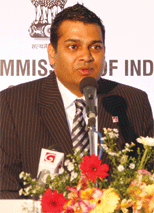Dilip Thakore interviewed Sanjeev Bolia, the peripatetic promoter-chairman and chief executive of Afairs Exhibitions and Media Pvt. Ltd (AEM/Afairs) over the telephone in Kolkata and Kathmandu. Excerpts:
 How satisfied are you with the growth and development of Afairs?
How satisfied are you with the growth and development of Afairs?
The company has achieved a lot during the past 20 years, but there’s a lot more to achieve. Following liberalisation and deregulation of the Indian economy in 1991, there’s a new and growing awareness of the value of high quality school and higher education within the country’s fast-expanding middle class. Therefore parents are anxious to provide the best education experience for their children.
Moreover low annual rates of economic growth in Western countries, rising unemployment and falling household incomes have made India’s top-ranked schools and colleges, which offer high-quality, globally benchmarked English medium educ-ation and year round good weather for sports education, an attractive proposition for households with a tradition of providing private educ-ation. These developments have created excellent conditions for the growth of Afairs.
How satisfactory is the response from schools and colleges, your prime revenue sources?
Four-fifths or 80 percent of the schools and colleges which showcase their institutions in our exhibitions and fairs are repeat customers who have been with us for over five years. They need high quality platforms and forums to present their globally benchmarked institutions in which they have invested huge financial and other resources, to attract students. Our exhibitions and fairs which are held across 27 cities in India and in eight countries abroad, enable them to achieve these objectives. Our estimate is that our exhibitions have facilitated over 3,000 foreign students admissions during the past eight years and have placed a large number of Indian schools on the global map.
Likewise, what’s the feedback from parent and student communities?
For parents, our IIPSE (Indian and International Premier Schools Exhibition) started in 2004, and staged in 16 cities across India, is a real blessing. In every exhibition they get access to infor-mation, faculty and admission officers of 40-50 schools offering quality Indian and international education. Afairs education fairs are eagerly anticipated because they enable parents to com-pare and contrast and pick and choose the best available and affordable schools for their children.
Since 2007 AEM has begun staging The Great India Education Fair (TGIEF) which showcases a mix of schools and colleges in eight countries including Thailand, Nepal, Bangladesh, Malaysia, Sharjah etc. How successful is this initiative?
Very successful because we are adding new countries to our itinerary every year and the number of exhibitor institutions is rising continuously. For instance in our very first IIPSE exhibition-cum-fair in Thailand in 2007 we had only 25 participants. During the past three years we have been averaging 50-60 institutions, and to date more than 350 Indian schools have exhibited in our TGIEF fairs abroad. International schools are enthusiastic participants in our education fairs abroad because they are genuinely interested in diversifying their mix to include foreign students.
According to all rating and ranking agencies India has a poor reputation for providing quality education. In the circumstances how do you explain the rising influx of foreign students into our schools and colleges?
There have always been islands of excellence in India’s K-12 and college education. Through word-of-mouth publicity these institutions have been attracting students from abroad — especially from NRI families — since the early years after independence. These institutions have become more popular in the past two decades because of greater media exposure and the emergence of several companies including Afairs which have started offering exhibition and related services to enable excellent schools to show-case their world class infrastructure, English medium international curric-ulums and excellent year-round sports facilities. All this plus very affordable fees by global standards, make India’s islands of education excellence very attractive to foreign parents and students.
How optimistic are you about the future of Afairs and Indian education?
Very optimistic. In the last 20 years Afairs has achieved a lot. But we have barely scratched the surface of the huge market for quality education. Foreign parents apart, even Indian households are not aware of the rising islands of education excellence which provide quality, holistic education to suit all budgets in India. Moreover with a huge volume of private investment flowing into education and with increasing interest cutting across all classes in quality education, standards are improving continuously. Even in higher education, the emergence of globally benchmarked private varsities is changing perceptions in India and abroad. Indeed, it’s time for the Central and state governments to start promoting India as an education destination, especially for affordable K-12 education.